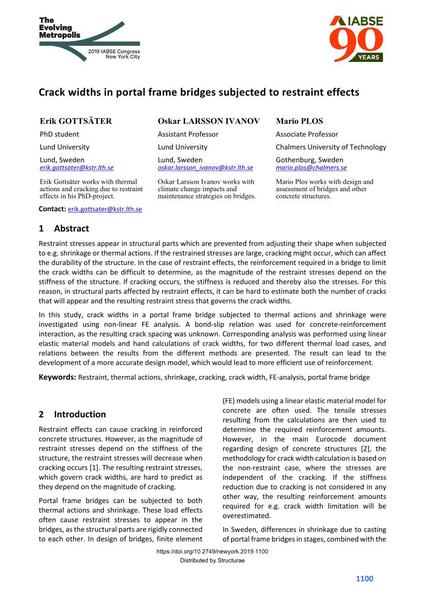Crack widths in portal frame bridges subjected to restraint effects

|
|
|||||||||||
Détails bibliographiques
| Auteur(s): |
Erik Gottsäter
(Lund University)
Oskar Larsson Ivanov (Lund University) Mario Plos (Chalmers University of Technology) |
||||
|---|---|---|---|---|---|
| Médium: | papier de conférence | ||||
| Langue(s): | anglais | ||||
| Conférence: | IABSE Congress: The Evolving Metropolis, New York, NY, USA, 4-6 September 2019 | ||||
| Publié dans: | The Evolving Metropolis | ||||
|
|||||
| Page(s): | 1100-1104 | ||||
| Nombre total de pages (du PDF): | 5 | ||||
| DOI: | 10.2749/newyork.2019.1100 | ||||
| Abstrait: |
Restraint stresses appear in structural parts which are prevented from adjusting their shape when subjected to e.g. shrinkage or thermal actions. If the restrained stresses are large, cracking might occur, which can affect the durability of the structure. In the case of restraint effects, the reinforcement required in a bridge to limit the crack widths can be difficult to determine, as the magnitude of the restraint stresses depend on the stiffness of the structure. If cracking occurs, the stiffness is reduced and thereby also the stresses. For this reason, in structural parts affected by restraint effects, it can be hard to estimate both the number of cracks that will appear and the resulting restraint stress that governs the crack widths. In this study, crack widths in a portal frame bridge subjected to thermal actions and shrinkage were investigated using non-linear FE analysis. A bond-slip relation was used for concrete-reinforcement interaction, as the resulting crack spacing was unknown. Corresponding analysis was performed using linear elastic material models and hand calculations of crack widths, for two different thermal load cases, and relations between the results from the different methods are presented. The result can lead to the development of a more accurate design model, which would lead to more efficient use of reinforcement. |
||||
